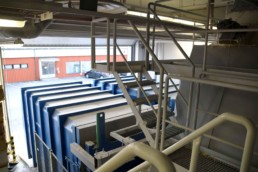Long-term waste management collaboration with Forssan kirjapaino
Forssa Print (Forssan Kirjapaino Osakeyhtiö) was founded in 1920. Three years prior to then, the local newspaper “Forssan Lehti” had been founded, but at the time printing houses were allowed to operate only in Finland’s biggest cities. Following legislative changes in 1920, however, printing activities were permitted also in Finnish provinces.
Esko Aaltonen, founder of Forssan Lehti, established Forssa Print in Forssa, which belonged to the municipality of Tammela. Forssa Print was the first Finnish printing house to be established in a rural municipality, and its first printing machine was ordered fittingly from Germany, birthplace of the original printing press.
Forssa Print prints newspapers, magazines, flyers and other promotional items, and it has operated in Forssa for over 100 years already. These days, Forssa Print is a separate limited liability company within the PunaMusta Media Group. Prepress Manager Jorma Aaltonen and Production Manager Jukka Aaltonen are actually related to the founder of Forssan Lehti and Forssa Print, Esko Aaltonen, who was the uncle of their grandfather.
Europress Service technician Juha Vallinen, Forssa Print’s Prepress Manager Jorma Aaltonen, Europress Executive Vice President Andreas Lemström and Forssa Print’s Poduction Manager Jukka Aaltonen
PunaMusta is committed to continuously and systematically reducing its immediate environmental impact in relation to the volume of production activities. The Group also guides its customers in making environmentally friendly choices and focuses procurements on environmentally responsible operators*. Almost all PunaMusta’s products are 100% carbon neutral.
Forssa Print has used Europress waste management equipment for over a decade. According to Jorma Aaltonen, its newest VersaMax waste compactors were customized for the printing house’s needs and installed in autumn 2020.
The printing machines in Forssa print reading materials that are distributed across Finland, and print numbers are high. Newspapers, magazines and flyers require enormous amounts of paper – each edition of one nationally distributed title requires 25 truckloads of paper.
The VersaMax waste compactors designed, manufactured and installed by Europress
Most of the printing house’s waste is in the form of scrap paper, 15 tonnes of which accumulates each day when cutting the sheets and making settings on the printing machines. The VersaMax waste compactors designed, manufactured and installed by Europress were customized to meet the demands of handling so much waste.
According to Jorma Aaltonen, Forssa Print has hardly had to call on the Europress service team, as the waste compactors have operated faultlessly. Scheduled maintenance is performed regularly in order to ensure that the printing house’s waste management equipment continues to operate faultlessly also in the future.
*Quoted from the PunaMusta website
Waste management devices in Forssa Print

Europress VersaMax
VersaMax is a easily customizable waste compactor designed to meet various needs of the waste and recycling industry customers.
Waste fractions: cardboard, plastic, mixed & energy waste








